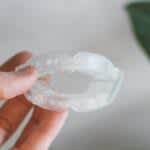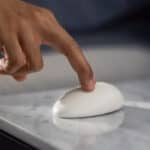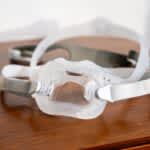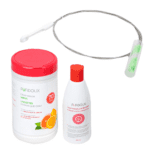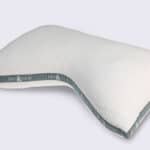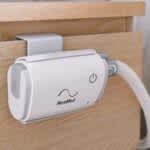If your air mattress isn’t staying inflated, a hole could be the culprit. While it’s normal for inflatable air mattresses to lose air over time, even a tiny tear can quickly reduce volume. Less inflation means weaker support, so it’s best to address the root cause as soon as possible.
Sharp objects or other accidents can cause air leaks, but sometimes a manufacturing defect is to blame. If you don’t think the hole is related to normal use, check the user manual before fixing the tear yourself. Holes and other damage are sometimes covered under the manufacturer’s warranty.
If an air mattress is the best mattress for your needs and you’re not eligible for warranty repair, you can try fixing the leak yourself. We’ll discuss some tips and tricks for how to fix a leaking air mattress.
What You’ll Need
Repairing a hole is fairly straightforward and only requires a few household items. Additionally, most temporary air mattresses come with a repair kit containing patches, adhesive, and an applicator.
Here is what you need to fix a leak:
- Patch kit: If your mattress doesn’t include a kit, then you can buy an alternative patch kit in a store or online. Patch colors vary, but you should be able to find one that’s a close enough match to your mattress.
- Sponge and mild soap: Cleaning the mattress surface with a washcloth or sponge dampened with dish soap or a mild detergent can help you locate the leak. Removing dirt, debris, and other sharp fragments from the surface can also prevent additional holes from forming.
- Tissue or paper towel: Using a tissue or paper towel can also help you pinpoint the leak by helping you see where air is coming out.
- Adhesive: This is essential if you don’t have a patch kit. Strong adhesives like hot glue, liquid cement, or epoxy are best because they dry airtight.
- Heavy object: A hardcover book or another heavy, flat item can help secure the air mattress patch.
Step-by-Step: How to Fix a Hole in an Air Mattress
- Find the leak. Areas with scuff marks or discoloration can sometimes indicate damage, but holes aren’t always visible to the naked eye. If that’s the case, inflate your mattress on a flat surface and listen for the sound of air escaping. You can also use your hand to feel for leaks.
Holes often develop along the seams and surrounding the valve, so carefully inspect these areas. The bottom side is also vulnerable to sharp objects.
If you still can’t identify the leak, place a single tissue or paper towel at one corner of the mattress. Apply pressure in the direction of the corner, slowly moving to other areas of the mattress. You’ll know you’ve found a hole if the tissue balloons up.
Another method is to dampen a cloth or sponge with water and a mild cleanser. Make sure you mix enough soap and water to form bubbles. Using the cloth or sponge, apply pressure to one area of the mattress. If bubbles increase, you’ve probably found the leak.
Holes aren’t always to blame for weak inflation. A loose valve can cause air to escape, so check that the seal is tightly fastened. Changes in external temperature and barometric pressure can also affect the volume of air in the mattress, in which case you’ll need to inflate the mattress more regularly.
- Clean and prep the area. Mark the damaged area with a permanent marker so you can easily locate the hole. Using a soapy cloth or sponge, thoroughly remove any dirt and debris from the surface. If there are rough spots, use very fine sandpaper to smooth out the area.
Rinse the cloth and wipe away any remaining soap from the mattress. Let the area dry completely before moving on to the next steps.
- Patch the leak. If you have a repair kit, follow the included instructions. A bike tire kit can also be used as an alternative. If you don't already have a kit, follow these steps:
- First, completely deflate your mattress and lay it on a flat surface with the leaking area face up.
- Next, make a patch out of durable plastic. Cutting a square from a vinyl shower curtain often works well. Add sturdy adhesive and apply the patch to the damaged area.
- Place a heavy object like a book or paperweight on the patch so that it fully adheres to the mattress.
- Keep the object on the patch for at least eight hours so that the glue dries completely. Once it’s dry, check that the patch is securely attached before inflating the mattress.
- Patching a ripped seam. The patch method won't work if the leak is caused by rips along the seam. If this is the case, you can use a hot glue gun to seal the tear. It's best to use a low temperature setting, making sure that the glue doesn't contact any other part of the mattress before drying. Bear in mind that the leak will return if the glue seal cracks or wears away. The hot glue or gun tip can damage certain mattress materials, so use caution with this method.
Both the patch and glue approaches will likely void your mattress warranty. If there are other parts that need replacing, such as the gasket, then even the most diligent repair won’t resolve the leak.
How to Know if Your Air Mattress Is Too Far Gone to Fix
While it’s possible to remedy a leak on your own, sometimes an air mattress is beyond repair. A few quick tests can determine if the mattress needs to be replaced.
- Test the seal. Once you’ve patched up the hole, check that the seal is airtight. When your mattress is fully inflated and on a flat surface, apply pressure around the patch to see if air escapes. If the seal isn’t leaking but the mattress continues to deflate, then there’s another hole or damaged area.
- Check the valve. A cracked or damaged valve can also create a leak. Valves are sometimes replaceable, so always check your user manual.
- Carefully inspect the seams. Minor rips along the seams can sometimes be remedied using a glue sealant, but this is often a temporary fix at best. Even the strongest glue will start to erode over time, causing the leak to reemerge. If your mattress still sags after sealing tears and patching holes, it’s probably time to dispose of the mattress and buy a new one.
Ask the Sleep Doctor
Have questions about sleep? Submit them here! We use your questions to help us decide topics for articles, videos, and newsletters. We try to answer as many questions as possible. You can also send us an email. Please note, we cannot provide specific medical advice, and always recommend you contact your doctor for any medical matters.





